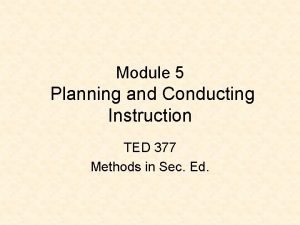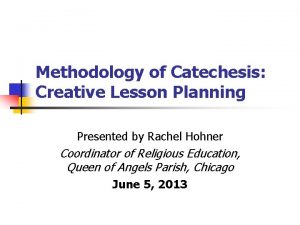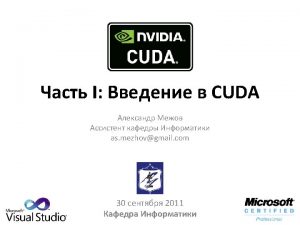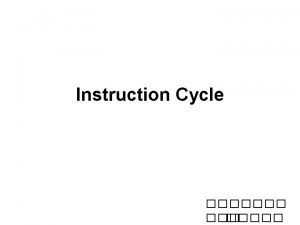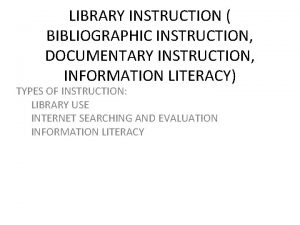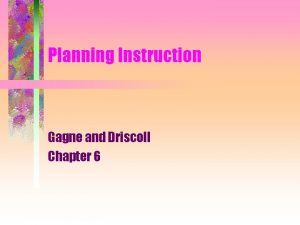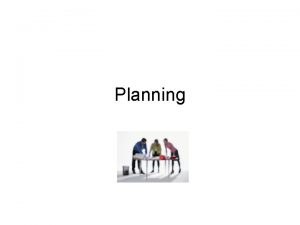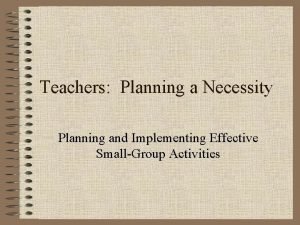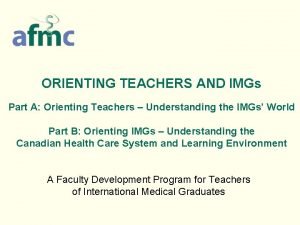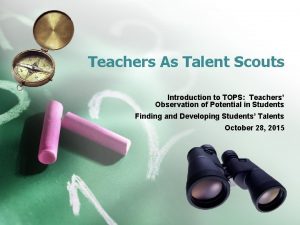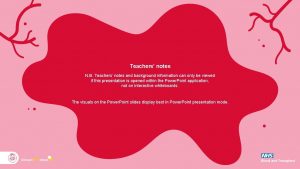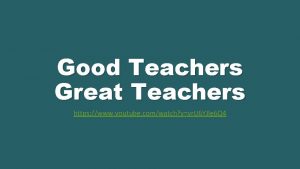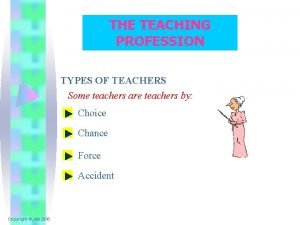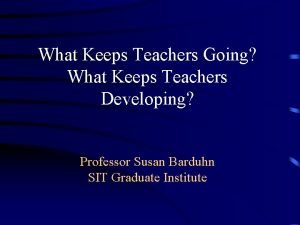11 Planning for Instruction Planning for Instruction Teachers









































- Slides: 41


11 Planning for Instruction

Planning for Instruction • Teachers cannot simply decide what they would like to teach • Society, parents, employers, and teachers all have a stake in making the educational system work well © Goodheart-Willcox Co. , Inc. Permission granted to reproduce for educational use only.

For Discussion • Who has an influence on what is taught in your state? © Michael D. Brown/Shutterstock © Goodheart-Willcox Co. , Inc. Permission granted to reproduce for educational use only.

Objective • Analyze the types of information included in the educational standards for a state. © Symbiot/Shutterstock © Goodheart-Willcox Co. , Inc. Permission granted to reproduce for educational use only.

Standards: What Should Students Know? • Educational standards (instructional goals) are statements of what students are expected to know and be able to do • Standards may be national, state, or developed by local districts • Standards are linked to the move for accountability in education © Goodheart-Willcox Co. , Inc. Permission granted to reproduce for educational use only.

For Discussion • What are the pros and cons of designing curriculum around educational standards? © Michael D. Brown/Shutterstock © Goodheart-Willcox Co. , Inc. Permission granted to reproduce for educational use only.

Objective • Compare curricula for the same course or level from two different sources. © Ilya Andriyanov/Shutterstock © Goodheart-Willcox Co. , Inc. Permission granted to reproduce for educational use only.

Curriculum: What Will Be Taught? • Curriculum is much more specific than standards about the content expected to be taught • Decisions about what to include in a curriculum may be heavily debated • May be developed by states, local school districts, and individual schools continued © Goodheart-Willcox Co. , Inc. Permission granted to reproduce for educational use only.

Curriculum: What Will Be Taught? • Development process usually involves a team of administrators, teachers, and others • The curriculum organizes the content in a logical way • It sets a plan for the main concepts and skills taught at each grade © Goodheart-Willcox Co. , Inc. Permission granted to reproduce for educational use only.

Objective • Explain the relationship between instructional units and course plans. © Franck Boston/Shutterstock © Goodheart-Willcox Co. , Inc. Permission granted to reproduce for educational use only.

Course Planning: How Will Learning Be Organized? • A course plan is based on curriculum, but adapted for the teacher, students, and teaching circumstances • Typically includes a series of instructional units • Must incorporate content and skills required to meet standards • A road map for day-to-day teaching continued © Goodheart-Willcox Co. , Inc. Permission granted to reproduce for educational use only.

Course Planning: How Will Learning Be Organized? • Influences and variables include – class and school schedules—how often does the class meet? for how long? – characteristics of the students—make reasonable assumptions based on what you know about child development – instructional units—sequence of topics in a logical order, often in outline form continued © Goodheart-Willcox Co. , Inc. Permission granted to reproduce for educational use only.

Course Planning: How Will Learning Be Organized? • Influences and variables include – opportunities for learning—special opportunities, such as an election, might mean adjusting topics in the schedule – teacher characteristics—the course plan will reflect the teacher’s individual strengths, interests, and teaching style continued © Goodheart-Willcox Co. , Inc. Permission granted to reproduce for educational use only.

Course Planning: How Will Learning Be Organized? • A course plan helps the teacher make sure everything that must be taught is included in the schedule • As the course progresses, the teacher will have to make adjustments © Goodheart-Willcox Co. , Inc. Permission granted to reproduce for educational use only.

Objective • Identify and describe the key parts of a lesson plan. © Coka/Shutterstock © Goodheart-Willcox Co. , Inc. Permission granted to reproduce for educational use only.

Lesson Plans: How Will Learning Take Place? • Lesson plans are also called instructional plans or teaching plans • Help teachers prepare for class by – documenting what is being taught – helping teachers think through what they will teach – better preparing teachers to teach the class – allowing substitutes to step in © Goodheart-Willcox Co. , Inc. Permission granted to reproduce for educational use only.

Elements of a Lesson Plan • May be a standard format determined by the school • Three basic parts include – instructional objectives – learning activities – assessment © Goodheart-Willcox Co. , Inc. Permission granted to reproduce for educational use only.

For Reflection • What do you think will be the most difficult part of preparing lesson plans? Why? © Archipoch/Shutterstock © Goodheart-Willcox Co. , Inc. Permission granted to reproduce for educational use only.

Objective • Write an educational objective that includes all necessary components. © armo. rs/Shutterstock © Goodheart-Willcox Co. , Inc. Permission granted to reproduce for educational use only.

Instructional Objectives • Lessons are developed to meet the instructional objectives, which – provide a focus for teaching – break down educational standards into smaller segments – are also called performance objectives continued © Goodheart-Willcox Co. , Inc. Permission granted to reproduce for educational use only.

Instructional Objectives • Well-written objectives – specify observable behavior—verb identifies how students will be learning – identify an action or product—concrete evidence that students are learning continued © Goodheart-Willcox Co. , Inc. Permission granted to reproduce for educational use only.

Instructional Objectives • Well-written objectives – describe any conditions—the circumstances under which the students will be learning – indicate acceptable level of performance— specifics on what determines success © Goodheart-Willcox Co. , Inc. Permission granted to reproduce for educational use only.

Learning Activities • Learning activities are the experiences used to help students learn the content continued © Jamie Wilson/Shutterstock © Goodheart-Willcox Co. , Inc. Permission granted to reproduce for educational use only.

Learning Activities • Discussions • Labs • Hands-on activities • Debates • Problem solving • Field trips • Computer exercises • Simulations • Experiments © Goodheart-Willcox Co. , Inc. Permission granted to reproduce for educational use only.

Assessment Strategies • Link directly to instructional objectives • Means for evaluating that learning has taken place © Alexander Raths/Shutterstock © Goodheart-Willcox Co. , Inc. Permission granted to reproduce for educational use only.

For Discussion • Which type of learning activities do you plan to use most often in your classroom? © Michael D. Brown/Shutterstock © Goodheart-Willcox Co. , Inc. Permission granted to reproduce for educational use only.

Other Lesson Plan Elements • Title—use one that is clear, descriptive • Topic—concept or skill being taught • Standards—those the plan achieves • Students/participants—grade level and subject area • Time period—how long the lesson plan will take to complete continued © Goodheart-Willcox Co. , Inc. Permission granted to reproduce for educational use only.

Other Lesson Plan Elements • Introduction – Captures students’ interest and attention – conveys teacher’s expectations – Links what students will be learning to what they already know • Step-by-step procedures—thinking through specific steps that will help the lesson go smoothly (including transitions) continued © Goodheart-Willcox Co. , Inc. Permission granted to reproduce for educational use only.

Other Lesson Plan Elements • Guided practice/independent practice— designed to reinforce and apply learning, either with feedback or as a personal practice activity • Summary—reviews what was learned and helps students apply it continued © Goodheart-Willcox Co. , Inc. Permission granted to reproduce for educational use only.

Other Lesson Plan Elements • Materials and equipment—everything needed to teach the lesson • Adaptations for students with special needs —ways to modify activities • Notes—additional information, reminders, and ideas for improvement © Goodheart-Willcox Co. , Inc. Permission granted to reproduce for educational use only.

For Reflection • Why do you think it is important to keep notes of ways to improve lesson plans? © Archipoch/Shutterstock © Goodheart-Willcox Co. , Inc. Permission granted to reproduce for educational use only.

Objective • Create a lesson plan on a chosen topic. © Matt Antonino/Shutterstock © Goodheart-Willcox Co. , Inc. Permission granted to reproduce for educational use only.

Finding Ideas and Inspiration • Experience will inspire teaching opportunities • Talk with other teachers • Read teaching magazines or websites • Collaborate in a team to write teaching plans • Keep notes and accumulate materials © Goodheart-Willcox Co. , Inc. Permission granted to reproduce for educational use only.

Making Plans Come Alive • Introduction – Capture students’ interest and attention – Engage them in learning – Let students know what you expect them to learn and how you want them to work – Link the learning to prior knowledge or experiences continued © Goodheart-Willcox Co. , Inc. Permission granted to reproduce for educational use only.

Making Plans Come Alive • Activities – use variety – incorporate an unexpected element – include opportunities for different learning styles, abilities, and interests – allow time for feedback, review, and reinforcement • Practice and be prepared to adapt © Goodheart-Willcox Co. , Inc. Permission granted to reproduce for educational use only.

For Discussion • How might you introduce a topic to capture your students’ attention? © Michael D. Brown/Shutterstock © Goodheart-Willcox Co. , Inc. Permission granted to reproduce for educational use only.

Evaluating the Lesson • Make notes about what worked • Think about modifications to improve the lesson plan © Darrin Henry/Shutterstock © Goodheart-Willcox Co. , Inc. Permission granted to reproduce for educational use only.

Key Points • Standards are developed at national, state, and local levels • Curriculums provide suggested or required classroom guidelines • Teachers use the curriculum to create a course plan • Lesson plans are specific day-to-day plans for teaching © Goodheart-Willcox Co. , Inc. Permission granted to reproduce for educational use only.

Review • What are educational standards? Ø statements of what students are expected to know and be able to do at certain points in their education • What are three most basic parts of a lesson plan? Ø instructional objectives, learning activities, assessment continued © Goodheart-Willcox Co. , Inc. Permission granted to reproduce for educational use only.

Review • What characteristics do well-written objectives include? Ø specify observable behavior; identify an action or product; describe any conditions; indicate acceptable level of performance • ____ are smooth ways to move from one part of the lesson to the next. Ø Transitions © Goodheart-Willcox Co. , Inc. Permission granted to reproduce for educational use only.
 Kim kroll
Kim kroll Site:slidetodoc.com
Site:slidetodoc.com Individualized instruction vs differentiated instruction
Individualized instruction vs differentiated instruction Planning and conducting instruction in the classroom
Planning and conducting instruction in the classroom Catechetical instruction lesson planning
Catechetical instruction lesson planning Referatmarkeringar
Referatmarkeringar Varför kallas perioden 1918-1939 för mellankrigstiden?
Varför kallas perioden 1918-1939 för mellankrigstiden? Programskede byggprocessen
Programskede byggprocessen Karttecken stig
Karttecken stig Fimbrietratt
Fimbrietratt Större och mindre tecken
Större och mindre tecken Fuktmätningar i betong enlig rbk
Fuktmätningar i betong enlig rbk Lufttryck formel
Lufttryck formel Elektronik för barn
Elektronik för barn Tack för att ni har lyssnat
Tack för att ni har lyssnat Borra hål för knoppar
Borra hål för knoppar Sura för anatom
Sura för anatom Smärtskolan kunskap för livet
Smärtskolan kunskap för livet Bris för vuxna
Bris för vuxna Frgar
Frgar Vad är ett minoritetsspråk
Vad är ett minoritetsspråk Novell typiska drag
Novell typiska drag Delegerande ledarstil
Delegerande ledarstil Indikation för kejsarsnitt på moderns önskan
Indikation för kejsarsnitt på moderns önskan Blomman för dagen drog
Blomman för dagen drog Redogör för vad psykologi är
Redogör för vad psykologi är En lathund för arbete med kontinuitetshantering
En lathund för arbete med kontinuitetshantering Mat för idrottare
Mat för idrottare Geometri för barn
Geometri för barn Claes martinsson
Claes martinsson Etik och ledarskap etisk kod för chefer
Etik och ledarskap etisk kod för chefer Svenskt ramverk för digital samverkan
Svenskt ramverk för digital samverkan Antika plagg
Antika plagg Datorkunskap för nybörjare
Datorkunskap för nybörjare Rita perspektiv
Rita perspektiv Vilken grundregel finns det för tronföljden i sverige?
Vilken grundregel finns det för tronföljden i sverige? Bamse för de yngsta
Bamse för de yngsta Densitet vatten
Densitet vatten Ministerstyre för och nackdelar
Ministerstyre för och nackdelar Sju principer för tillitsbaserad styrning
Sju principer för tillitsbaserad styrning Plats för toran ark
Plats för toran ark Tack för att ni lyssnade bild
Tack för att ni lyssnade bild



